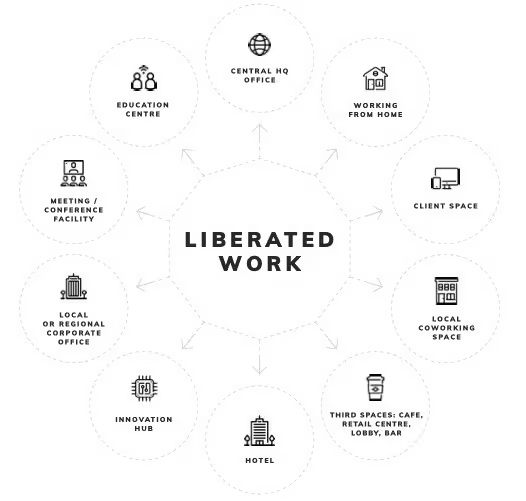Feeling my way through the darkness
New year and all, I’ve been persuaded to take another look at the whole future of work/office thing. It’s against my better judgement, because the toddlers are still fighting it out in the playpen.
So, I must start by restating:
1) There is no future of work
2) Neither is there an office of the future
3) But we are doomed to debate both in an endless loop, unless we learn the real lessons
White collar work and workplaces will continue to evolve; but, strangely, people need reminding that the offices of the past (think Francis Seale’s LOTs – Legacy Office Towers, or OAFs – Offices As Factories) won’t have a prosperous future!
Relogix’s recent global workplace usage study (including 125 companies and 259 offices) reveals utilisation rates still well below pre-pandemic levels:

So it isn’t that people don’t want shared workspaces and space outside the home. They just don’t want to commute for anything like a full week to a corporate office.
How much space will be shed? At the beginning of the pandemic, I forecast 25% for the average corporate. My simple rationale? I had delivered more than this over the preceding 6/7 years, on the back of flexible working policies, laptops and mobile phones en masse, and the judicious use of lease events. Plus, average desk utilisation in 2019 across private and public sectors in the UK was around 55%, including ‘signs of life’ (Colin Stuart will keep me honest here). Even some supply siders are now making bold claims about cuts. Take your pick.
But hey, maybe it’s nice and warm in the tar pit. Stick around and see how that works for you.
They say I’m caught up in a dream
‘Hybrid’ is omnipresent, but already defunct - sullied by binary thinking and lazy mandates. Distributed, or ‘liberated’ work (c John Preece) is the real deal; but how do we democratise it? Those still stuck in siloed RTO/WFH mode, should start with his graphic below:

Mass adoption will require a further cultural shift in management (it has clearly been a struggle for many, getting their heads around a pretty simple split of some days in the office and some at home), as well as a reallocation of the funds occupiers spend on real estate. Some of this is already flowing into the growing aggregator and enterprise platform market (think Hubli, Hubble, Desana, Upflex, Codi and Liquidspace).
Will 2023 be the year of asynchronicity and people mixing their days up more (rather than the office/home default)? Will the peak of the ‘mid-week mountain’ get softened at least? And how about a replacement for the well-worn Activity Based Working cookie cutter (whose hallmarks include dumb desk booking and ‘emperor with no clothes’ neighbourhoods)?
I’ve talked previously about how it’s human nature to double down on a bad bet. This is similar to the sunk cost fallacy, where someone resists changing a strategy because they are too highly invested in it, and partly explains why some occupiers have tried to push office attendance mandates or RTO/RTP (Return To Past). But clearly this isn’t only about filling surplus space (also known as doing the landlord’s job for it), it is also about doubling down on old and ineffective ways of working, typified by:
• Command and control – “I need my people where I can see them”
• Management by input – counting the hours
• Larping in the office - what sort of culture do you really have?
(Optional subplot - watercooler innovation – we don’t have room for here to discuss the inability of large incumbents to innovate. See ‘The innovator's dilemma’ by Clayton Christensen, when you have time).
The same psychology applies to how Commercial Real Estate develops, and contracts for space and how occupiers and the supply chain design, configure and operate it.
I still believe that things can be a whole lot better, if we manage to be a bit less blinkered. There is common ground where employers can hit more of their company objectives, reduce staff churn, improve productivity, efficiency and well-being. It’s just that the mental trench warfare humans tend to slip into so easily, stands in the way. Put someone on the defensive and they will defend an emotional response with all their mental skill and energy.
When I’m wiser and I’m older
2022 gave us many things (and took some precious ones away too). But one valuable addition has been a years’ worth Trustek audit data, over 3m sq ft (279k sq m). Out of the offices surveyed, the stats reveal:
• Wellbeing – 14.8/100 avg. (Highest 87.3 / Lowest 2.6)
• Connectivity – 33.8/100 avg. (Highest 98 / Lowest 4.6)
• Occupancy Data – 44/100 avg. (Highest 79.3 / Lowest 5)
• Customer Experience – 38.6/100 avg. (Highest 96.3 / Lowest 2)
• ESG – 26.2/100 avg. (Highest 79.6 / Lowest 6)
• Compliance – 76.4/100 avg. (Highest 100 / Lowest 14.6)
The last five arguably feed into the first.
Of course, connectivity is close to my heart. How many times has someone swanned around an empty CAT A floor, glanced at their phone and said, “coverage is fine, I’ve got three bars”. Cue facepalms from experts, who know that adding several hundred users to an empty space will need solid coverage and capacity on all mobile networks throughout.
The problem with the usual reactive approach to challenges (eg: “how will we share space? – let’s buy a desk booking system”), is that all the above metrics are interconnected. We all need to take a big step back and start asking the broader questions about what space we really need, when, where and how it should be constructed, configured, connected and conducted (sorry, I can’t resist the alliteration).
And once we have done so, we need to talk an in depth look at what our buildings and building systems are capable of (shameless plug). I like to promote ‘adult conversations’ about how and where we work as individuals and as teams. Clearly there need to be a whole lot more of these, including how our buildings and organisations are still setup to fail.
I tried carrying the weight of the world
Current carbon reduction policies in place are projected to result in global warming of 2.8°C this century. And implementing unconditional and conditional Nationally Determined Contributions only reduces this to 2.6°C and 2.4°C respectively (ref: UN Environment Programme).
Given that buildings (not just offices) account for around 33% of global carbon emissions (ref: IEA Tracking Report), there is a huge onus on the sector to act; however, greenwashing is still widespread. Even where well intended, low level tactical improvements (such as using more sustainable materials for tenant fit outs) fail to address the root of the problem. In short, we have to flip our whole approach from ‘what can we build?’ to ‘how can we avoid building and use existing stock effectively?’.
Everyone has a part to play. If tenants hoard surplus space and don’t deal with the ‘mid-week mountain’ then they are partly responsible for developers sinking huge volumes of embodied carbon into the ground for unnecessary new office developments. Even I need to reduce my ‘beach towelling’ (apologies to Anna Watson 😊).
Sharing workplaces, in all ways possible, is essential. And labelling a workplace ‘sustainable’ because there is LED lighting, a bit of ‘biophyllic’ planting and some reused furniture fabric, is frankly a farce, particularly if a perfectly serviceable existing space has been ripped apart on a whim.
I didn’t know I was lost
So, it’s not hopeless. 2023 needn’t be Groundhog Day, just don’t expect it to be a revelation either. Do expect plenty more Bill Murray moments along the way. But eventually the snow will melt, and we will be able to set out on the road again, even if we aren’t quite sure where it ends.
If in doubt, follow your internal compass to where the value is. And in the meanwhile, there’s always Chat GPT. Its output makes as much, or more sense than a lot of what passes for good advice in our industry.
P.S: for those who haven’t spotted it yet, here’s the link (or should I say thread?)
References:
Upflex funding round announcement
UN Environment Programme - Emissions Gap Report 2022: The Closing Window
IEA Tracking report — September 2022
LARPing your job - Anne Helen Petersen
Relogix - Navigating the World of Hybrid Work
Beachtowelling, the curse of an agile workspace










-2.jpg)
.jpg)



